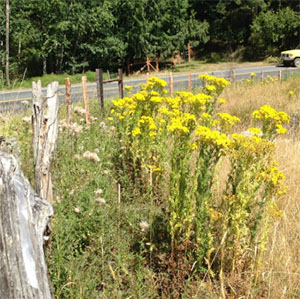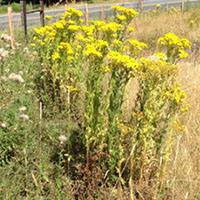— from Jason Ontjes —
 Tansy ragwort, one of San Juan County’s worst noxious weeds, is now in flower along roadsides, in fields and in residents’ yards. Highly toxic, its alkaloids are present in all plant parts. Cattle, horses and goats consuming either growing plants or tansy ragwort in silage and hay, store these poisons in their livers (Jacobs, J. 2009 USDA- NRCS). Even if symptoms are not noticeable, or appear minor, the cumulative toxins cause irreversible liver damage, resulting in reduced weight, and possibly, sudden death in previously healthy animals.
Tansy ragwort, one of San Juan County’s worst noxious weeds, is now in flower along roadsides, in fields and in residents’ yards. Highly toxic, its alkaloids are present in all plant parts. Cattle, horses and goats consuming either growing plants or tansy ragwort in silage and hay, store these poisons in their livers (Jacobs, J. 2009 USDA- NRCS). Even if symptoms are not noticeable, or appear minor, the cumulative toxins cause irreversible liver damage, resulting in reduced weight, and possibly, sudden death in previously healthy animals.
While horses and cattle will normally avoid tansy in pastures, it loses its characteristic odor when dried in hay, thus these animals are unable to distinguish it from the rest of the forage. Additionally, they can accidentally ingest leaves of the first-year rosettes when they are imbedded with emerging spring grass. Sheep are considered more resistant to its toxic effects. Because of its threat to livestock, including domestic poultry, every effort needs to be made to find and eradicate this plant from pastures and hayfields. Also, please be aware that tansy ragwort can cause human liver damage, and should never be used as an herbal remedy or tea. Tainted dairy milk can have an off-taste, and honey derived from tansy may be unpalatable.
Tansy ragwort, also known as ‘stinking willie’ or ‘staggerwort’, is native to northern Africa, Asia, and Europe. It is easily recognized while in flower. No other locally common member of the daisy family has bright yellow flowers with thirteen petals (ray florets) and soft, frilly leaves, coupled with an unpleasant odor when crushed or pulled. Depending on the conditions, it may mature between a few inches to more than six feet in height.
[perfectpullquote align=”right” cite=”” link=”” color=”#778899″ class=”” size=””] Tansy ragwort can cause human liver damage [/perfectpullquote]
Mowing does not ultimately control tansy ragwort. Cut plants will re-flower closer to the ground and, although normally biennial, will likely become perennial when cut. A study of 179 plants in Australia found 2% were annuals, 45% biennials, and 39% were perennials. The seed life is about fifteen years.
Tansy (Senecio jacobaea) is best controlled by pulling the entire plant out of the ground, but it is critical to remove the flower heads—if present—before discarding the rest of the plant. These heads should be bagged and taken to the solid waste facility, where they may be disposed of at no charge. If the heads are left on the plant, the seeds will mature and re-infest the area which is being cleared. This is especially important along roadsides where the flower heads and developing seeds can be picked up by tires and dispersed over great distances. Please remember to wear gloves when handling this toxic plant.
You may see black and orange/yellow-striped caterpillars of the cinnabar moth, Tyria jacobaea, eating the leaves and flowers on some plants. If there are only a few found on the plant, we usually pull the plant and shake them off onto nearby tansy rosettes. If numerous caterpillars are defoliating the plants, we usually leave them alone. When ready to pupate, they leave their host plant, but unfortunately, the plants can re-flower and set seed even if completely defoliated.
For more information, please call the Noxious Weed Program staff at 360-376-3499, or consult the Washington State Noxious Weed Board’s website: www.nwcb.wa.gov/weeds/tansy-ragwort.
Many thanks for all of your tansy ragwort removal efforts over the years.
Special Thanks to Judy Jackson and Rich Lee for writing this article.
**If you are reading theOrcasonian for free, thank your fellow islanders. If you would like to support theOrcasonian CLICK HERE to set your modestly-priced, voluntary subscription. Otherwise, no worries; we’re happy to share with you.**









I was out for 6 hours bagging the flowers and pulling up/digging out tansy ragworts today. Only got one large paper shopping bag of flowers in the Spring Point/Suncrest neighborhoods. No seeds had yet formed. My neighbors and I have been working together for several years to try to control this truly nasty weed.
Janet — Let’s take a walk next week in another neighborhood. You’re a great teacher!